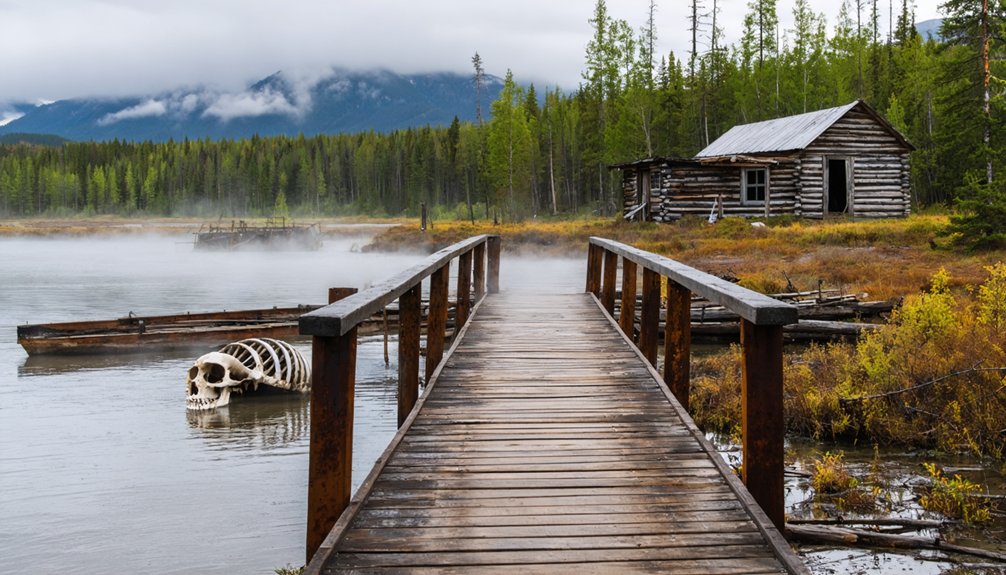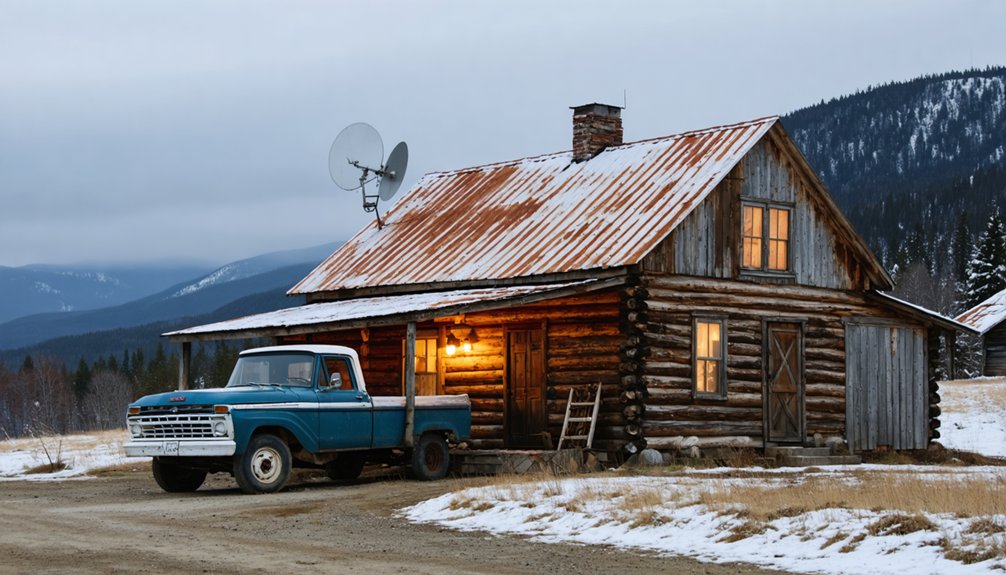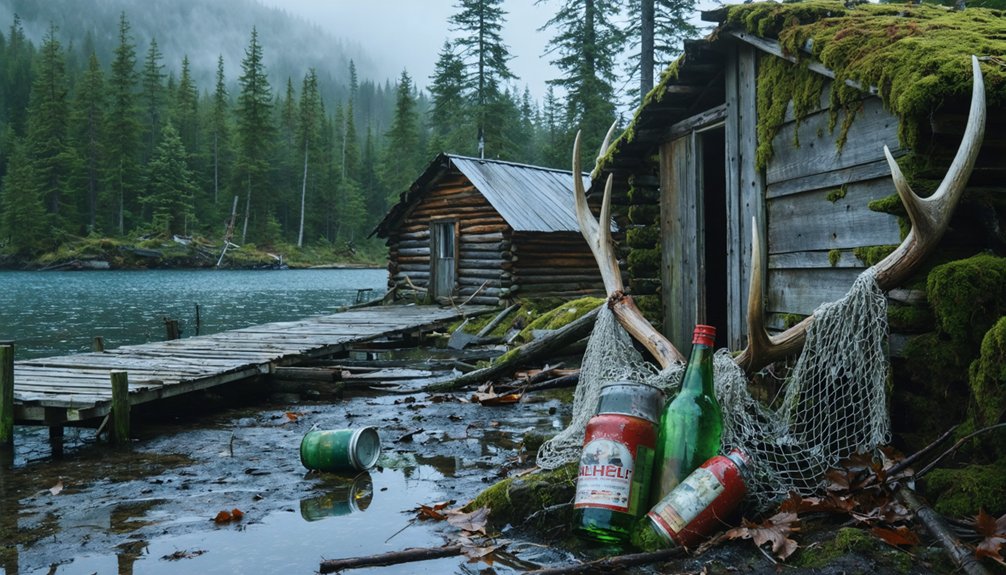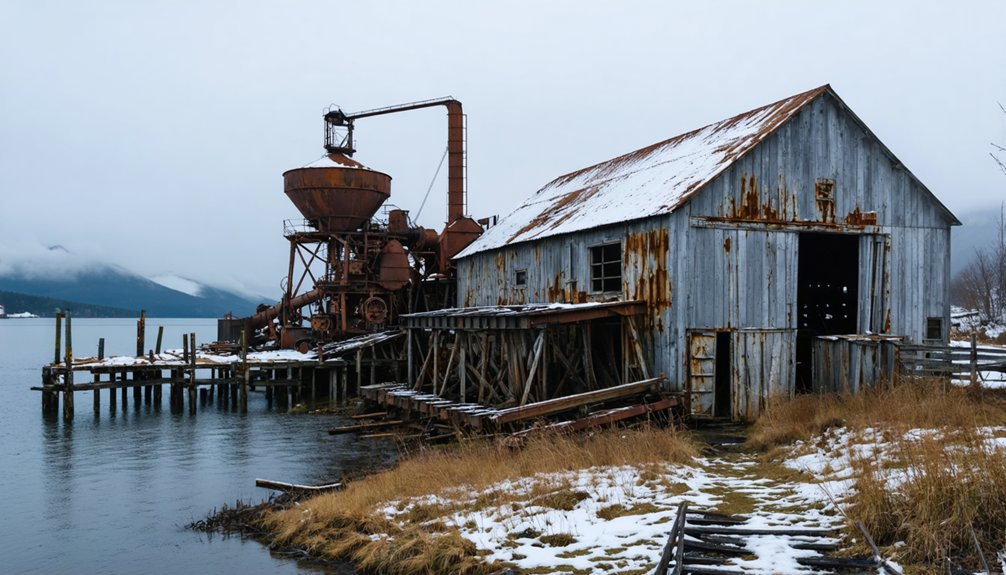You’ll find Eagle, Alaska nestled along the Yukon River, where an 1880s fur trading post exploded into a gold rush boomtown of 1,700 residents by 1898. While the population dropped after gold discoveries in Nome and Fairbanks, today’s 87 residents maintain this living ghost town’s rich heritage through preserved Fort Egbert buildings, the historic courthouse, and active Han Athabascan traditions. The town’s authentic frontier spirit beckons you to uncover its remarkable past.
Key Takeaways
- Eagle is not a true ghost town, maintaining a small but active population of 87 residents with modern amenities and services.
- The town’s population plummeted from 1,700 in 1898 to fewer than 200 by 1910 due to gold discoveries in Nome and Fairbanks.
- Fort Egbert’s closure in 1911 contributed to Eagle’s significant decline, though five original fort buildings still stand today.
- The Taylor Highway’s completion in 1951 preserved Eagle’s connectivity, preventing it from becoming completely abandoned like other gold rush settlements.
- Eagle remains a living historic district with preserved gold rush-era structures, original log cabins, and active cultural heritage preservation.
The Birth of a Gold Rush Settlement (1897)
While Eagle began as a modest fur trading post in 1880, the discovery of gold on American Creek in 1897 transformed this Yukon River settlement into a bustling frontier hub.
A humble fur outpost until 1897, Eagle transformed when gold fever struck, turning this Yukon River settlement into a booming frontier town.
Situated just 12 river miles from the Canadian border, you’d find Eagle perfectly positioned as the last American stop before reaching the legendary Klondike gold fields.
As news of the gold discovery spread, thousands of determined prospectors faced the challenging journey, hauling their supplies over treacherous mountain passes like the Chilkoot to reach the Yukon’s waters.
Many who’d struck out in the Klondike turned their hopes to Eagle’s promising creeks. The settlement quickly adapted to serve these fortune seekers, with merchants establishing sturdy log cabin stores along the riverbank to outfit prospectors for their next adventure. Like in Skagway’s bustling streets, Eagle’s economy thrived more from supplying miners than from actual gold mining.
Canadian authorities required each prospector to carry a year’s worth of food supplies to prevent starvation in the harsh conditions.
From Boom to Bust: Eagle’s Population Journey
As the nineteenth century drew to a close, Eagle’s population skyrocketed to over 1,700 residents in 1898, transforming this Yukon River outpost into Alaska Interior’s most prominent frontier city.
You’d find prospectors, entrepreneurs, and settlers flooding in, drawn by the promise of Klondike gold and opportunity. High above the town, you could spot massive eagle eyries perched in the tall cliffs overlooking the Yukon River.
But Eagle’s glory days wouldn’t last. New gold discoveries in Nome and Fairbanks lured fortune seekers away, triggering a dramatic population decline.
By 1910, you’d see fewer than 200 people remaining in town. The closure of Fort Egbert in 1911 and relocation of the federal court to Fairbanks sealed Eagle’s fate.
Today, you’ll find just 87 residents, mostly elderly, living among the preserved Gold Rush-era buildings that tell the story of Eagle’s meteoric rise and fall. The median age of 70.8 years reflects the town’s status as a retirement haven for those seeking solitude in this historic frontier outpost.
Life at the Edge: Fort Egbert’s Military Legacy
When the U.S. Army established Fort Egbert in 1899, you’d have witnessed a bold move to tame Alaska’s wild frontier. Under Captain Charles Farnsworth’s command, this strategic outpost transformed Eagle into an essential hub for military operations, law enforcement, and communications.
Fort Egbert stood as America’s pioneering force in Alaska, transforming the untamed wilderness into an organized military and communications center.
You’ll find that frontier challenges shaped daily life at the fort, where soldiers and civilians formed tight bonds to survive the harsh environment. They’d hunt together near the Fortymile River and socialize at the “Club of Twelve Cranks.” The fort’s location along the Yukon River banks provided a crucial vantage point for monitoring regional activities. By 1906, the fort had grown into a substantial military installation with nearly forty buildings supporting its operations.
The fort’s military legacy extends beyond its law-keeping mission – it became the cornerstone of the Washington-Alaska Military Cable and Telegraph System, where future Air Force pioneer Billy Mitchell helped build critical communication lines.
Even explorer Roald Amundsen used the fort’s telegraph to announce his historic Northwest Passage achievement in 1905.
Trading Post Tales: Belle Isle and Early Commerce
Before Eagle City became a gold rush boomtown, François Mercier’s Belle Isle Trading Post marked the first foothold of American commerce along this stretch of the Yukon River.
You’ll find its trading post significance deeply rooted in the partnerships forged with local Han Athabascan people at David’s Village, setting the stage for decades of cross-cultural exchange.
The Taylor Highway provides modern access to this historic trading site.
The early commerce impacts transformed this remote outpost into a thriving hub by the late 1800s:
- Three major mercantile companies and a sawmill established operations in Eagle’s first year
- Mississippi-style sternwheelers connected Eagle’s port to towns from Saint Michael to Whitehorse
- The Customs House regulated cross-border trade, cementing Eagle’s role as a crucial gateway between Alaska and Canada
By 1898, the settlement’s rapid growth led to a population exceeding 1,700 as prospectors and traders flocked to the area.
Today, preserved buildings and artifacts tell the story of Eagle’s pioneering merchants and their frontier enterprise.
Historic Architecture and Preservation Efforts
Since its founding in 1897, Eagle’s architectural heritage has evolved from hastily-built frontier cabins into a treasured collection of gold rush-era structures.
You’ll find the town’s authentic character preserved within the Eagle Historic District, where original log cabins and military buildings stand as evidence of frontier ingenuity. The architectural significance of Fort Egbert’s 45 buildings, including officers’ quarters and the hospital, shaped Eagle’s development beyond its mining camp origins.
Fort Egbert’s historic buildings and original log cabins showcase the resourceful spirit that transformed Eagle from mining outpost to thriving settlement.
Today’s historic preservation efforts maintain the genuine feel of early 1900s life.
You can explore Judge Wickersham’s 1901 courthouse, the old Army mule barn, and numerous period structures that tell the story of Eagle’s unique blend of civilian and military history.
These carefully maintained buildings offer you a direct connection to Alaska’s rugged past.
Natural Wonders: Eagles, Wildlife, and Landscapes
Along the wild banks of the Yukon River, Eagle’s natural landscape provides an ideal habitat for its namesake raptors – both bald and golden eagles. Similar to Alaska’s Chilkat River, thousands of eagles gather here during seasonal salmon runs.
You’ll find these magnificent birds soaring above the rugged terrain, where pristine wilderness meets the rushing waters. The area’s unique combination of old-growth trees, riverine corridors, and open tundra creates perfect conditions for eagle viewing and wildlife photography. These powerful birds can reach impressive speeds of 120-160 km/h when diving for prey.
- Bald eagles frequent the riverbanks year-round, building massive nests in tall trees within 200 meters of the water’s edge.
- Golden eagles patrol the higher terrain, hunting ground squirrels and occasionally young Dall sheep in the nearby alpine areas.
- Both species congregate during salmon runs, offering spectacular opportunities to witness their impressive wingspans and hunting skills.
Transportation Evolution: From River to Highway

You’ll find Eagle’s early transportation history dominated by the mighty Yukon River, which served as an essential lifeline for supplies, mail, and travelers during the gold rush era.
While packhorses and primitive trails eventually connected Eagle to other settlements, the community remained heavily dependent on seasonal river transport well into the 20th century.
Everything changed when the Taylor Highway reached Eagle in 1951, finally connecting the remote community to Alaska’s growing road network and making year-round vehicular access possible for the first time.
River Travel Dominates Early
Before the advent of highways and air travel, the mighty Yukon River served as Eagle’s essential transportation artery, with the first steamers appearing in 1866 when the Collins Overland Telegraph Company introduced the vessel *Wilder*.
You’d find river navigation thriving as steamboats became the lifeline of this remote frontier community, connecting you to the outside world through mail, freight, and passenger service.
- Wood-fueled steamboats like the *Yukon* and *St. Michael* plied these waters, with local woodchoppers supplying fuel for their hungry boilers.
- By 1899, you’d see 30 steamers working the river, transforming Eagle into a bustling transportation hub.
- During the gold rush’s peak, over 130 steam vessels navigated these waters, offering you an alternative to the grueling Chilkoot Trail.
Taylor Highway Changes Everything
As the post-war years ushered in new opportunities for Alaska’s remote communities, the construction of the Taylor Highway from 1947 to 1951 revolutionized transportation in Eagle and the Fortymile region.
The 160-mile route finally connected Eagle’s infrastructure to Alaska’s central highway system, ending decades of isolation and dependence on riverboats.
You’ll find the Taylor Highway impact was immediate and far-reaching. The road transformed Eagle from a river-dependent outpost to a highway-accessible destination, though it’s only open from April to mid-October.
While the first 60 miles are paved, the rest remains gravel, maintaining that frontier feel you’re seeking. The highway’s connection to the Top of the World Highway at Jack Wade Junction opened up new possibilities, letting you drive all the way to Dawson City, Yukon during summer months.
Indigenous Heritage and Cultural Significance
The rich cultural heritage of Eagle, Alaska centers on the Han Gwich’in Athabascans, who’ve made their home along the Upper Yukon River for thousands of years.
For millennia, the Han Gwich’in Athabascans have shaped Eagle’s cultural landscape, their traditions flowing like the mighty Yukon River.
Their cultural continuity remains strong in Eagle Village, where traditional practices of hunting, fishing, and gathering sustain both body and spirit.
Despite the changes brought by the Gold Rush era, the Han people have preserved their way of life while adapting to modern times.
- You’ll find fishwheels still turning in the Yukon River, a reflection of time-honored fishing methods.
- You can hear elders sharing stories and keeping their language alive through oral traditions.
- You’re witnessing living history in Eagle Village, where about half the residents maintain their Han heritage.
These deep cultural roots continue to shape Eagle’s identity, even as the community faces contemporary challenges.
Modern Living in a Historic Frontier Town

Living in modern-day Eagle offers a unique blend of frontier charm and contemporary comfort, where residents have adapted historic buildings and spaces to meet today’s needs.
You’ll find modern amenities like internet and power, though they’re more limited than in urban areas. Despite the town’s small population of 87, you’ll experience strong community engagement through shared activities and mutual support.
The older demographic, with a median age of 70.8, shapes the town’s relaxed pace, while the mix of subsistence living and tourism keeps the economy moving.
You can enjoy the benefits of lower housing costs compared to Alaska’s cities, though you’ll need to plan for higher transportation expenses and seasonal challenges.
Remote work opportunities and traditional crafts provide ways to earn while maintaining the freedom of frontier living.
Tourism and Heritage: Eagle’s Second Wind
Once a thriving gold rush hub, Eagle now draws visitors seeking authentic frontier experiences through its remarkable blend of preserved history and natural beauty.
You’ll find heritage tourism thriving here, with five original Fort Egbert buildings and the historic Wickersham courthouse standing as symbols to Alaska’s frontier days. The Native Village of Eagle actively preserves its Hungwitch’in cultural heritage while welcoming travelers to their remote paradise.
- Stay at Eagle Campground’s 18 sites near Fort Egbert and explore the surrounding Yukon River wilderness.
- Visit the Yukon-Charley Rivers National Preserve headquarters for deep insights into local history.
- Experience authentic cultural preservation through guided tours of historic buildings and Native cultural sites.
The Taylor Highway brings you to this living museum for roughly half the year, where about 70 residents maintain their unique frontier lifestyle.
Frequently Asked Questions
What Activities Are Available for Winter Visitors to Eagle, Alaska?
You’ll find endless winter sports like snowmobiling, cross-country skiing, and snowshoeing. Don’t miss wildlife photography opportunities, ice fishing, and exploring historic buildings in this remote wilderness community.
How Do Residents Receive Medical Care in Such a Remote Location?
You’ll rely on local clinics staffed by health aides for basic care, while telemedicine options connect you with distant specialists. In emergencies, you’ll need medevac services to reach major hospitals.
What Are the Current Costs of Living in Eagle, Alaska?
You’ll face steep costs in this remote outpost, where housing expenses run high and grocery prices soar 27% above national averages. Your utilities and transportation also demand premium rates for frontier living.
Which Specific Wildlife Species Can Tourists Expect to See Year-Round?
You’ll spot bald eagles, gyrfalcons, and northern hawk owls year-round, making wildlife photography rewarding. For bird watching enthusiasts, snowy owls, voles, squirrels, and otters are consistently present throughout seasons.
How Do Eagle’s Residents Handle Education for School-Age Children Today?
Like eagles nurturing their young, you’ll find local kids attend Eagle Community School while having access to homeschooling options. You’re free to tap into community resources through Alaska’s DEED and tribal education programs.
References
- https://coloradosghosttowns.com/eagle alaska.html
- https://en.wikipedia.org/wiki/Eagle
- https://www.nps.gov/yuch/learn/historyculture/eagle-city.htm
- https://walter-us.net/Alaska/main/Eagle/eagle_history.htm
- https://npshistory.com/publications/yuch/brochures/eagle-city.pdf
- https://www.litsitealaska.org/index.cfm?section=Digital-Archives&page=Government&cat=Military&viewpost=2&ContentId=2731
- https://www.explorenorth.com/alaska/history/eagle-history.html
- https://npshistory.com/publications/yuch/brochures/eagle.pdf
- https://www.nps.gov/articles/alaska-goldrush-national-historic-landmarks.htm
- https://npshistory.com/publications/yuch/am-side-of-the-line.pdf



